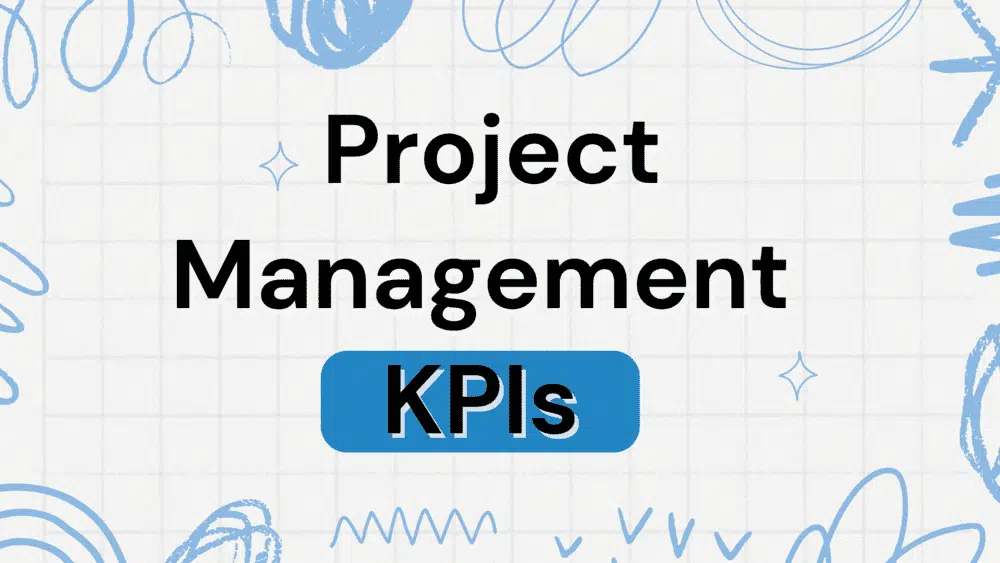Tracking key performance indicators (KPIs) is crucial to project success. If you do not track project management KPI metrics, you cannot review and measure the project’s progress against the planned progress. These project management KPIs will show how close or far away you are from achieving your project objectives.
Depending on the type and industry, a project can have many KPIs, and as a project manager, you must identify the most useful KPIs for your project. Tracking the wrong project KPIs will waste your precious time and can provide false and misleading information. So, tracking the right project KPI is also important.
Although it is difficult to detail a complete set of key performance metrics for project management, I will provide 39 of the most popular -management KPIs in this post.
Let’s first understand what project KPIs are.
What Are Project KPIs?
Traditionally, we used to measure three project constraints: scope, time, and cost, collectively known as the triple constraints. However, project managers track more than these three project management constraints these days.
The six key project constraints are as follows:
- Schedule: You must complete the project within the agreed-upon duration. Schedule constraints are related to the project schedule. They define milestones and ensure that project deliverables are delivered on time.
- Cost: You must complete the project within the allocated budget. Cost constraints involve managing expenses related to resources, materials, labor, equipment (direct and indirect costs), etc., to prevent cost overruns.
- Scope: The project must deliver defined features and functionalities. Scope constraints define what is included and excluded in the project deliverables and ensure that the project meets stakeholders’ requirements.
- Quality: The project deliverables must meet the specified quality standards. Quality constraints ensure that deliverables meet or exceed defined quality criteria and satisfy customer needs.
- Risk: You must effectively manage risks and uncertainties. Risk constraints involve identifying, assessing, and controlling risks by developing a risk response plan.
- Resources: You must optimally use resources (e.g., personnel, equipment, materials, and facilities). Resource constraints involve managing resource availability, allocation, and utilization.
Best Practices for Creating and Using Project KPIs
The following are the best practices for creating and Using KPIs for your project:
1. Select the Right Project Management KPIs
This is the most important step in selecting the KPI. You must select the relevant KPIs for your project that are useful and help you track your progress. You can measure the project performance and communicate it to the stakeholders.
Selecting the wrong project management KPIs will waste your effort and mislead your project objectives. The selected KPIs should directly align with the project goals and objectives. They should reflect what the project aims to achieve, as well as the desired outcomes.
2. Keep KPIs Simple
The KPI should be simple and easy to understand so stakeholders can understand them and make necessary decisions.
Avoid overwhelming yourself and your team with too many KPIs. Focus on the most relevant metrics that truly measure progress and success. Each KPI should be clear, concise, and easily understandable.
3. Use SMART Criteria
Ensure your project KPIs are SMART, which stands for Specific, Measurable, Achievable, Relevant, and Time-bound. This ensures you can measure and assess the project progress using the KPIs.
Select a combination of quantitative and qualitative KPIs. While quantitative measures provide concrete data, qualitative measures can offer valuable insights into customer satisfaction, team morale, stakeholder engagement, etc.
4. Regularly Review, Benchmark, and Adjust
As a project manager, you must regularly review and evaluate project KPIs to track progress and make informed decisions. You can do so monthly, quarterly, or annually, depending on the project’s duration and complexity.
Compare your KPIs against industry standards and/or benchmarks to understand how your project performs relative to others in similar domains. This will help you identify areas for improvement and set realistic targets.
Adjust and refine your KPIs as the project progresses and circumstances change. Flexibility is key to ensuring that your KPIs remain relevant and effective throughout the project lifecycle.
39 Project Management KPIs
Now, I will provide you with the 39 sample KPIs for project management divided under each of the six categories mentioned above. You can review them, understand their purpose, and select the most suitable for your project requirements.
Note that these KPIs are industry-independent, and you can use them with any project management methodology such as Agile, waterfall, or hybrid.
Schedule Management KPIs
- Schedule Variance (SV): The schedule variance measures the variance between the earned value (EV) and planned value (PV) at a specific point in time. A positive SV indicates that the project is ahead of schedule, while a negative SV suggests delays.
- Schedule Performance Index (SPI): The schedule performance index assesses schedule efficiency by comparing the earned value (EV) of work completed to the planned value (PV). An SPI value greater than 1 indicates that the project is ahead of schedule, while a value less than 1 indicates delays.
- Percentage Complete: Percentage complete measures task progress against planned work. It provides a simple, effective way to measure project progress.
- Critical Path Length Index (CPLI): CPLI measures the ratio of actual critical path length to planned critical path length. A CPLI greater than 1 suggests schedule compression, while a value less than 1 indicates schedule extension.
- Number of Schedule Changes: This KPI tracks the frequency and magnitude of changes made to the project schedule. It helps assess the stability of the schedule and the effectiveness of change-management processes.
- On-Time Completion Percentage: On-time completion percentage measures the percentage of tasks completed within deadlines. It provides insight into the project’s ability to meet its scheduled commitments.
- Lead-and-Lag-Time Utilization: Lead time is the delay between the start of a predecessor task and its successor task, while lag time is the delay between the finish of a predecessor task and the start of its successor task. Monitoring their use helps optimize the project schedule.
- Schedule Baseline Compliance: This KPI measures how closely the project schedule follows the schedule baseline. It helps assess the impact of changes and deviations to the original plan.
- Schedule Forecast Accuracy: This KPI compares the accuracy of initial schedule forecasts to actual project progress over time. It helps assess the reliability of scheduling estimates and improve future planning processes.
Cost Management KPIs
- Cost Variance (CV): The cost variance measures the difference between earned value (EV) and actual costs (AC), thus indicating whether the project is under or over budget. A positive CV shows cost savings, while a negative CV indicates cost overruns.
- Cost Performance Index (CPI): The cost performance index compares earned value (EV) to actual costs (AC), thus indicating the efficiency of cost utilization. A CPI greater than 1 indicates cost efficiency, while a CPI less than 1 suggests cost overruns.
- Variance at Completion (VAC): Variance at completion shows the difference between budgeted cost at completion (BAC) and estimated cost at completion (EAC). It provides insights into cost deviations from the original budget.
- Estimate at Completion (EAC): Estimate at completion forecasts the total cost of completing the project based on current performance and anticipated future conditions, thus predicting the final project cost and budget adjustments.
- Return on Investment (ROI): ROI measures the project’s profitability by comparing the project’s net gain to the total investment cost. It provides insight into the project’s financial performance.
- Cost of Non-Quality: Cost of non-quality calculates the expenses incurred due to defects, rework, and quality issues, thus reflecting the impact of poor quality management on project costs.
Scope Management KPIs
- Scope Baseline Compliance: Scope baseline compliance measures the degree to which project activities align with the scope baseline. It indicates how well the project follows the scope plan and monitors changes and deviations.
- Scope Creep Rate: Scope creep rate quantifies the frequency and magnitude of unauthorized and/or uncontrolled changes to the project scope. This project-management KPI assesses the impact of scope changes on project objectives, timelines, and resources, thus effectively identifying and mitigating scope creep.
- Requirements Stability Index (RSI): RSI evaluates the stability of project requirements over time. A higher RSI indicates greater stability, thus minimizing the need for scope changes and enhancing project predictability and success.
- Scope Change Requests: Scope change requests track the number and nature of proposed changes to the project scope. They provide insights into stakeholders’ needs and manage scope changes effectively to prevent scope creep.
- Percentage of Deliverables Completed: This KPI measures the number of project deliverables completed against the planned deliverables. It shows the project’s progress and helps measure the achievement of project objectives.
Quality Management KPIs
- Defect Density: Defect density measures the average number of defects identified per unit of measurement (e.g., lines of code or product units). It indicates the quality level of the deliverables and helps prioritize defect-resolution efforts to improve overall quality.
- Customer Satisfaction Score: Customer satisfaction score quantifies the level of satisfaction or dissatisfaction among customers regarding the product or service delivered. It provides valuable insights into customer preferences, expectations, and areas for improvement.
- First-Time Pass Rate: The first-time pass rate measures the percentage of products or deliverables that pass quality inspections or tests on the first attempt without requiring rework or corrections. It reflects the efficiency of production and/or development processes and highlights areas for process optimization.
- Failure Rate: Failure rate calculates the percentage of products and/or deliverables that fail to meet specified quality standards or requirements. It helps identify weaknesses in processes and/or materials, thus guiding corrective actions to reduce failure rates and improve the product and/or process quality.
- Number of Non-Conformities: The number of non-conformities tracks the total number of instances in which products, processes, and/or services deviated from established quality standards. It highlights areas for improvement and guides corrective actions to enhance quality and compliance.
- Cost of Quality (COQ): Cost of quality quantifies the expenses incurred to ensure product and/or service quality (e.g., prevention, appraisal, and failure costs). It helps assess the efficiency of quality management practices and guides investment decisions to optimize quality-related expenses.
- Internal Quality Index: The internal quality index assesses the quality level of internal processes, systems, and/or products within an organization. It provides a benchmark for comparing quality performance over time and against industry standards, thus driving continuous improvement efforts.
- On-Time Delivery Rate: On-time delivery rate measures the percentage of products and/or services delivered to customers within the agreed-upon delivery timeframes. It reflects the reliability of delivery processes and enhances customer satisfaction by meeting or exceeding delivery expectations.
Risk Management KPIs
- Risk Exposure Index: The risk exposure index quantifies the overall level of risk exposure faced by a project, considering the probability and potential impact of identified risks. It provides a view of risk exposure, thus enabling prioritization of risk-response efforts and resource allocation.
- Risk Response Effectiveness: Risk response effectiveness evaluates the efficiency of implemented risk responses in mitigating or eliminating identified risks. It assesses whether the chosen response strategies adequately address risk factors and contribute to achieving project objectives.
- Risk Severity Index: The risk severity index assesses the severity of identified risks on project objectives. It prioritizes risks based on their impact severity, thus guiding resource allocation and focusing on high-priority risks to manage their effects.
- Risk Trigger Monitoring: Risk trigger monitoring tracks predefined indicators and/or events that signal the emergence or escalation of identified risks. It facilitates proactive risk management by enabling early detection.
- Risk Contingency Use: Risk contingency use measures the use of contingency plans and/or reserves allocated to address risks. It evaluates the effectiveness of contingency measures in risk management.
- Risk Response Time: Risk response time assesses the speed and efficiency of the response process to identified risks, from risk identification to implementing response actions. It helps minimize delays in addressing risks and mitigating their potential impacts on project objectives.
Resource Management KPIs
- Resource Utilization Rate: The resource utilization rate measures the proportion of available resources that are actively engaged in project work over a specific period. It indicates how effectively resources are used and identifies over and/or underutilization issues.
- Resource Allocation Efficiency: Resource-allocation efficiency evaluates how efficiently resources are assigned to tasks and/or projects relative to their availability and skillsets. It ensures optimal resource utilization and maximizes productivity while minimizing idle time and bottlenecks.
- Resource Turnover Rate: The resource turnover rate quantifies the frequency at which resources join and/or leave the project team over a specific period. It helps assess the stability of the project team and identifies factors that influence resource turnover (e.g., workload, job satisfaction, and/or organizational culture).
- Resource Competency Index: The resource competency index assesses the proficiency and expertise of resources in performing assigned tasks and/or roles. It ensures that resources possess the necessary skills and qualifications to fulfill project requirements effectively, thus minimizing errors and rework.
- Training Hours Per Employee: Training hours per employee quantifies the training and/or professional development provided to project team members over a specific period. It ensures that resources receive the necessary skills and knowledge to perform their roles effectively, thus enhancing overall project performance and employee satisfaction.
Summary
Project management key performance indicators (KPIs) play a crucial role in assessing and monitoring project success. By effectively implementing and using KPIs, project managers can gain insights into various aspects of project performance.
By leveraging project management KPIs, organizations can improve efficiency and deliver successful outcomes that align with stakeholders’ expectations and business objectives.

I am Mohammad Fahad Usmani, B.E. PMP, PMI-RMP. I have been blogging on project management topics since 2011. To date, thousands of professionals have passed the PMP exam using my resources.







